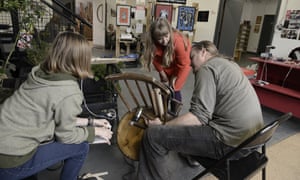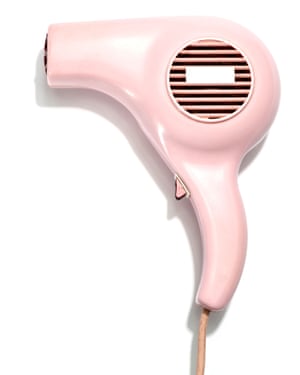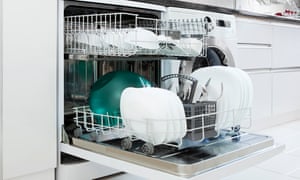BBC Two - The Repair Shop
It is a pleasure to watch beautiful things being mended:
BBC Two - The Repair Shop, Series 2, Episode 6, Toy Steam Battleship
As referred to in a piece from the Guardian last year:
Meet the ‘fix-perts’, an army of experts determined to get Britain on the mend
The Repair Café names the seven easiest things you can fix yourself (and that includes laptops), saving you a small fortune and benefiting the environment
Every year British households chuck out £800-worth of electrical goods, nearly half of which goes straight into landfill. Yet many of those items – as well as wonky bits of furniture – suffer a premature death that could be avoided with a simple repair. Trouble is, most householders have no confidence in their ability to fix things, and have been (profitably) trained to dispose of goods and buy new. But householders in many parts of the UK can now find a Repair Café where, over tea and biscuits, volunteer “fix-perts” give them the knowledge to help themselves in future.
Martine Postma launched the concept in Amsterdam in late 2009, and there are now 1,256 Repair Cafés around the world. They are all staffed by volunteers and designed to be free meeting spaces where visitors can bring their broken items, or just pop in and browse the selection of DIY books. They join the increasing number of events and workshops across the UK that can help you tackle the repair jobs yourself.
Over on BBC2’s The Repair Shop, it too aims to be an “antidote to the throwaway culture” – albeit with an emphasis that is firmly on sentimental rather than monetary value, inspiring viewers to repair and restore much-loved but damaged heirlooms instead of throwing them in the skip. Items featured have ranged from a favourite childhood toy and a 70s talking Dalek that had lost its ability to, well, talk, to a late grandad’s cherished Victorian garden gnome so badly battered and bruised he had been hidden away in a cupboard.
Victoria Jackson set up a branch of Repair Café in Brighton five years ago. As she says: “Most things can be fixed with a bit of imagination and lateral thinking. Electrical items can be tricky and are most in demand as people have a fear of opening them. One of the issues with repairing, as an individual, is that it often takes place behind closed doors in the privacy of our homes. By creating these social – and they are very social – events, it becomes a shared activity.”
A survey this week by insurer Aviva revealed how little confidence people have with even basic electricals. It found that 21% are not confident changing a light bulb, while 43% are nervous about wiring a plug.
Janet Gunter is co-founder of the Restart project, whose motto is “Let’s fix our relationship with electricals”, and which aims to help people and businesses move beyond a throwaway economy. She says laptops and smartphones are easily the most commonly brought-in devices. “A lot of the time there’s anger at why an object has stopped working, and we try to redirect that in a positive way. There’s a sense of outwitting manufacturers for a lot of people.” Upcoming workshops include ones in Leicester and Leytonstone, east London.
Commercial enterprises are also latching on to a desire, both environmental and financial, to mend rather than chuck out. Alison Winfield-Chislett set up the Goodlife Centre in London to offer workshops in DIY and home maintenance, and also hosts free sessions where visitors bring in a broken item for assessment. “We host them on Sunday afternoons for local people who sit with our volunteer ‘fix-perts’. It’s amazing how it changes people and their relationship with stuff. They go home confident, and proudly send in pictures of what they have achieved.
“We have a modern culture where people are just ignorant about how electrical things work. We are frightened of electrics because we are ignorant of electrics. But they come to a repair workshop and, well, have a light bulb moment that they can actually fix something.”
Here are the seven easiest items that people can fix:
1 Lamps
If you’re fearful of electrics this is the starting point, as they are about as basic as it gets. “Lighting really is the simplest thing to repair,” says Winfield-Chislett. “You can easily take apart a light fitting and replace cables and switches.”
If you’re fearful of electrics this is the starting point, as they are about as basic as it gets. “Lighting really is the simplest thing to repair,” says Winfield-Chislett. “You can easily take apart a light fitting and replace cables and switches.”
Normally it’s simply the bulb that’s gone or a problem with the fuse, which can also be easily replaced in the plug. A replacement bulb holder can also be bought very cheaply and is a doddle to install. As with any electrical appliance you need to make sure the lead and plug aren’t frayed or cracked. If they are, they will need to be dealt with first.
It could also be an issue with a faulty switch which can quite often be replaced, though you might prefer to be shown in person how to repair that one first time round.
2 Laptops and smartphones
Screen replacements are a feasible and relatively cheap fix to do yourself at home. It’s easy to buy new screens online – for example, you can find replacement Acer Aspire screens for around £60 – and there are lots of online tutorials explaining how to go about it. My husband replaced a laptop screen in about 30 minutes following one of these, having never done it before.
Screen replacements are a feasible and relatively cheap fix to do yourself at home. It’s easy to buy new screens online – for example, you can find replacement Acer Aspire screens for around £60 – and there are lots of online tutorials explaining how to go about it. My husband replaced a laptop screen in about 30 minutes following one of these, having never done it before.
The Restart Project’s Gunter says: “New operating systems often leave ‘old’ machines behind. Also, people often give up on devices that run slowly when there are simple fixes.
“Sometimes malware is a cause of slowdowns, and good security online is part of being a resilient user of technology, as is backing up personal data – something that so many people neglect to do!”
3 Hairdryers
My first ever hairdryer lasted me nearly 30 years. I was very fond of the old thing. Since it died I’ve been through a few and they never seem to last more than a couple of years before something goes wrong, so I was pleased to hear from the Repair Café team in Brighton that this is another commonly fixable item.
My first ever hairdryer lasted me nearly 30 years. I was very fond of the old thing. Since it died I’ve been through a few and they never seem to last more than a couple of years before something goes wrong, so I was pleased to hear from the Repair Café team in Brighton that this is another commonly fixable item.
Its electrical repair guru, Mattia Cobianchi, explains: “If it works but is smelly, something is stuck in the proximity of the heating elements, and every time it’s switched on it keeps burning. Sometimes hair can get entangled in the fan and electric motor, slowing it down and making it overheat. Opening the hairdryer and cleaning the motor and fan fixes it. If it doesn’t switch on at all, the troubleshooting sequence for a hairdryer should be: check the fuse in the plug and inspect the cable for cuts; open the plastic case (use a plastic spudger tool to avoid breaking the plastic); and check the switch or find if a fuse in the vicinity of the switch has blown.”
4 Kettles
If the basic functionality of a kettle – heating water by way of an element – has stopped working, a repair is a distinct possibility. According to Cobianchi, “usually the switch has become oxidized because of the sparking which happens every time you use it. Over time the surface develops a thin layer of oxide, which is an insulator, preventing the switch from working. Cleaning with isopropyl alcohol is usually enough”.
If the basic functionality of a kettle – heating water by way of an element – has stopped working, a repair is a distinct possibility. According to Cobianchi, “usually the switch has become oxidized because of the sparking which happens every time you use it. Over time the surface develops a thin layer of oxide, which is an insulator, preventing the switch from working. Cleaning with isopropyl alcohol is usually enough”.
5 Vacuum cleaners
If you have children then it’s highly likely that at sometime you’ve experienced having to coax a Captain America mini-figure or suchlike out of the tube. You can inadvertently block a vacuum cleaner in any number of places, and if the motor is running and the suction has suddenly gone, it’s probably either a blockage or simply because it needs emptying.
If you have children then it’s highly likely that at sometime you’ve experienced having to coax a Captain America mini-figure or suchlike out of the tube. You can inadvertently block a vacuum cleaner in any number of places, and if the motor is running and the suction has suddenly gone, it’s probably either a blockage or simply because it needs emptying.
Otherwise, if the machine has stopped working altogether, Cobianchi says that after initial safety checks “it could be the switch, or in an old appliance that the carbon brushes of the motor could be worn out, or a turn in the motor winding could have broken and needs to be re-soldered”.
6 Toasters
The build-up of crumbs causes a number of problems, so as a first step hold the toaster upside down over a bin and simply give it a good shake. However, taking it apart is perhaps a step too far for most people. Winfield-Chislett says: “My toaster was on the blink and I suspected a moist raisin had short-circuited it. But it was just so difficult to take apart. They are designed to push you into disposability. I did manage a repair in the end but the fine wires that make up the heating element are difficult to get hold of.”
The build-up of crumbs causes a number of problems, so as a first step hold the toaster upside down over a bin and simply give it a good shake. However, taking it apart is perhaps a step too far for most people. Winfield-Chislett says: “My toaster was on the blink and I suspected a moist raisin had short-circuited it. But it was just so difficult to take apart. They are designed to push you into disposability. I did manage a repair in the end but the fine wires that make up the heating element are difficult to get hold of.”
7 Washing machines, dishwashers and cookers
Unless you happen to be built like Giant Haystacks, larger appliances are likely to be too big to be lugged to a repair event, but there are a few safe actions you can try at home. Blockages due to the build-up of food or debris can be easily rectified. If you always use quicker, low-temperature washes it pays to do a hot cycle to stop bacteria building up and clogging the system.
Unless you happen to be built like Giant Haystacks, larger appliances are likely to be too big to be lugged to a repair event, but there are a few safe actions you can try at home. Blockages due to the build-up of food or debris can be easily rectified. If you always use quicker, low-temperature washes it pays to do a hot cycle to stop bacteria building up and clogging the system.
It’s also incredibly straightforward to take out and clean filters in a dishwasher. Parts that normally go – plastic and metal moveable pieces – can be replaced simply. Likewise, on a washing machine the doors often get bashed and the hinge can break, but you can buy another and fix it simply yourself.
Fixing cookers is going to be beyond most people. Winfield-Chislett says repairs usually represent better value than buying a new oven. She recommends Curry’s Knowhow service. It charges £119 for a one-off repair of an electric cooker, and you don’t have to have bought it from Currys.
Meet the ‘fix-perts’, an army of experts determined to get Britain on the mend | Money | The Guardian
See also:
Can we fix it? The repair cafes waging war on throwaway culture | World news | The Guardian
.
.
.








No comments:
Post a Comment